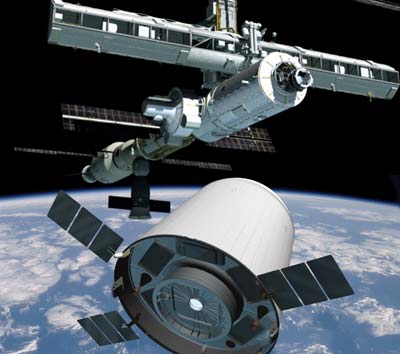Will NASA support space entrepreneurs?by Taylor Dinerman
|
| Between 2006 and 2010, which is the earliest date the CEV could become operational, NASA is going to have to find a way to either pay the Russians or find another means for getting up and back. |
After the President gave his January 14, 2004 speech presenting the Vision For Space Exploration, which he hopes will take people back to the Moon and, eventually, to Mars, the OSP program was replaced. The Crew Exploration Vehicle will now be developed not only for the ISS missions, but also as part of the spaceships that will go beyond Earth orbit. To pay for most of this, the President proposes shutting down shuttle operations in 2010 and cutting back drastically on ISS operations after about 2016.
Between 2006 and 2010, which is the earliest date the CEV could become operational, NASA is going to have to find a way to either pay the Russians or find another means for getting up and back. NASA is also going to have to find a way to send its share of supplies up to the station without using the shuttle. Mike Griffin, the new NASA administrator, is quoted saying that “NASA exists to work at the frontier. Today the frontier should not be the delivery of five or ten tons to the station.”
The big contractors, such as Lockheed Martin and Boeing, may not be interested in simple logistical delivery systems. Certainly, the ones being built by the Europeans and the Japanese are expensive and complex pieces of technology whose real purpose is more about creating expertise than efficiently delivering cargo. Russia’s Progress cargo delivery vehicle is an unmanned version of the Soyuz capsule. Like most Russian hardware, it has proved itself robust and reliable.
Mike Griffin is encouraging some of the more entrepreneurial companies to come up with suggestions for solving the problems. The commonly used analogy is to the Defense Department’s travel system. When the DoD wants to send someone from Washington to Denver, they do not write up a separate set of specifications for the airliner: they just buy a ticket. Ideally, that would be the way NASA would send astronauts, supplies, and equipment to and from the ISS.
| NASA should begin to buy space transportation services directly from the private sector instead of buying launch vehicles in the same complex and bureaucratic way the Pentagon buys bombers. |
Sadly, we have seen this before. NASA has had a terrible record dealing with small and innovative space companies. This time, things may be different. The success of the Ansari X Prize and the team lead by Burt Rutan have given the small space sector a level of credibility it never had before. There is also the fact that Mike Griffin not only has an impressive background in physics and engineering, but also has worked with one relatively small space company, Orbital Sciences Corporation, and was president and COO of In-Q-Tel, the venture capital fund set up by the CIA to promote innovative technologies for their needs.
NASA should begin to buy space transportation services directly from the private sector instead of buying launch vehicles in the same complex and bureaucratic way the Pentagon buys bombers. For cargo services this should be relatively easy, but if they want to buy transport services for astronauts from the entrepreneurial sector the safety requirements will have to be very carefully written. Too strict and they will make it impossible for anyone to compete; too loose and they will be putting lives at risk unnecessarily.
If the do succeed in opening the space agency to this new service purchasing philosophy the change in the organization’s culture will be profound. This will be a major step towards opening up space for those who dream of building a self-sustaining human civilization beyond Earth.
